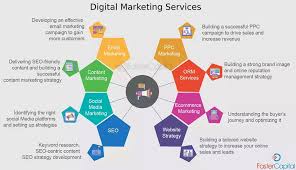The Power of Online Advertising
In today’s digital age, online advertising has become a crucial component of marketing strategies for businesses of all sizes. With the vast reach and targeting capabilities of online platforms, advertisers can connect with their target audience in more personalized and effective ways than ever before.
Targeted Reach
One of the key advantages of online advertising is its ability to target specific demographics, interests, and behaviors. Through data analytics and tracking tools, advertisers can tailor their ads to reach the right audience at the right time. This targeted approach not only increases the chances of reaching potential customers but also maximizes the return on investment.
Cost-Effectiveness
Compared to traditional forms of advertising such as print or TV commercials, online advertising offers a more cost-effective solution. Advertisers can set their budgets, monitor performance in real-time, and adjust campaigns accordingly to optimize results. This flexibility allows businesses to reach a wider audience without breaking the bank.
Engagement and Interactivity
Online advertising enables brands to engage with their audience in interactive ways. From clickable display ads to engaging video content, advertisers can create immersive experiences that capture users’ attention and drive action. By encouraging interaction through likes, shares, comments, or clicks, brands can foster deeper connections with their target market.
Measurable Results
Unlike traditional advertising methods where measuring ROI can be challenging, online advertising provides detailed metrics for tracking performance. Advertisers can monitor key performance indicators such as click-through rates, conversion rates, impressions, and more to gauge the effectiveness of their campaigns. This data-driven approach allows for informed decision-making and continuous optimization.
Conclusion
Online advertising has revolutionized the way businesses promote their products and services. With its targeted reach, cost-effectiveness, engagement opportunities, and measurable results, online advertising offers a powerful tool for driving brand awareness, generating leads, and increasing sales in today’s competitive marketplace.
Top 8 Frequently Asked Questions About Online Advertising
- What is online advertising?
- How does online advertising work?
- What are the benefits of online advertising?
- What are the different types of online advertising?
- How can I measure the effectiveness of my online advertising campaigns?
- What platforms can I use for online advertising?
- How much does online advertising cost?
- What are some best practices for creating successful online ads?
What is online advertising?
Online advertising refers to the practice of promoting products, services, or brands on the internet through various digital channels. It encompasses a wide range of formats, including display ads, social media ads, search engine marketing, email marketing, and more. Online advertising allows businesses to reach their target audience in a more targeted and cost-effective manner compared to traditional advertising methods. By leveraging data analytics and tracking tools, advertisers can tailor their campaigns to specific demographics, interests, and behaviors, ultimately driving engagement, leads, and sales online.
How does online advertising work?
Online advertising works by leveraging digital platforms to display promotional content to a targeted audience. Advertisers use a variety of tactics such as display ads, search engine marketing, social media advertising, and native advertising to reach potential customers online. Through data analytics and tracking tools, advertisers can identify their target demographics, interests, and behaviors to deliver personalized ads that are more likely to resonate with viewers. By setting specific goals, monitoring performance metrics, and optimizing campaigns based on real-time data, advertisers can effectively engage with their audience, drive traffic to their websites, generate leads, and ultimately achieve their marketing objectives through online advertising strategies.
What are the benefits of online advertising?
Online advertising offers a multitude of benefits for businesses looking to enhance their marketing strategies. Some key advantages include targeted reach, cost-effectiveness, engagement opportunities, and measurable results. By leveraging data analytics and tracking tools, advertisers can precisely target their desired audience, increasing the effectiveness of their campaigns. The flexibility of online advertising allows businesses to set budgets, monitor performance in real-time, and adjust strategies accordingly for optimal results. Additionally, the interactive nature of online ads fosters engagement with users, leading to deeper connections and increased brand awareness. With detailed metrics available for tracking performance, businesses can measure the success of their online advertising efforts and make informed decisions to drive growth and achieve their marketing goals.
What are the different types of online advertising?
There are several types of online advertising that businesses can leverage to reach their target audience effectively. Some common forms of online advertising include display ads, which are visual ads that appear on websites and social media platforms; search engine marketing (SEM), which involves placing ads on search engine results pages based on specific keywords; social media advertising, where ads are displayed on popular social networks like Facebook, Instagram, and LinkedIn; video advertising, which includes pre-roll and mid-roll video ads on platforms like YouTube; and native advertising, which seamlessly integrates promotional content into the user’s online experience. Each type of online advertising offers unique benefits and can be tailored to suit different marketing objectives and budgets.
How can I measure the effectiveness of my online advertising campaigns?
To measure the effectiveness of your online advertising campaigns, you can utilize various key performance indicators (KPIs) such as click-through rates, conversion rates, cost per acquisition, return on ad spend, and website traffic metrics. Tracking these KPIs allows you to assess the impact of your campaigns on driving user engagement, generating leads, and ultimately converting them into customers. Additionally, implementing conversion tracking tools and attribution models can provide valuable insights into the customer journey and help you optimize your campaigns for better performance. By analyzing these metrics regularly and making data-driven decisions, you can continuously improve the effectiveness of your online advertising efforts.
What platforms can I use for online advertising?
When considering online advertising, there are various platforms available to reach your target audience effectively. Popular options include social media platforms like Facebook, Instagram, Twitter, and LinkedIn, where you can run targeted ads based on users’ demographics, interests, and behaviors. Search engine advertising through Google Ads allows you to display ads to users actively searching for relevant keywords. Additionally, display advertising networks like Google Display Network and programmatic ad platforms offer opportunities to reach a broader audience across websites and apps. Each platform has its strengths and targeting capabilities, so it’s essential to evaluate your goals and target audience to determine the most suitable platforms for your online advertising campaigns.
How much does online advertising cost?
The cost of online advertising can vary widely depending on various factors such as the platform used, the targeting criteria, the ad format, and the competitiveness of the industry. Generally, online advertising offers flexibility in budgeting, allowing advertisers to set their spending limits based on their goals and resources. Some platforms work on a pay-per-click (PPC) model where advertisers only pay when users interact with their ads, while others may charge based on impressions or conversions. It’s essential for businesses to carefully plan their online advertising budget and strategy to maximize the effectiveness of their campaigns while staying within their financial constraints.
What are some best practices for creating successful online ads?
When it comes to creating successful online ads, there are several best practices that can help maximize their effectiveness. Firstly, it’s essential to clearly define the target audience and tailor the ad content to resonate with their interests and preferences. Using compelling visuals, concise copy, and a strong call-to-action can grab the viewer’s attention and prompt them to take action. Additionally, optimizing ads for mobile devices, testing different variations to see what works best, and analyzing performance data to make informed adjustments are key strategies for creating impactful online advertisements that drive results.




